Amalie Robert Estate Climate Update: September Vintage 2020 - Say It Taint So!
Hello and Welcome,
This is an Amalie Robert Estate Climate Update: September Vintage 2020. This is the Big One. A Farming bLOG FLOG communication from Dena & Ernie @AmalieRobertEstate. Oregon Willamette Valley Pinot Noir.
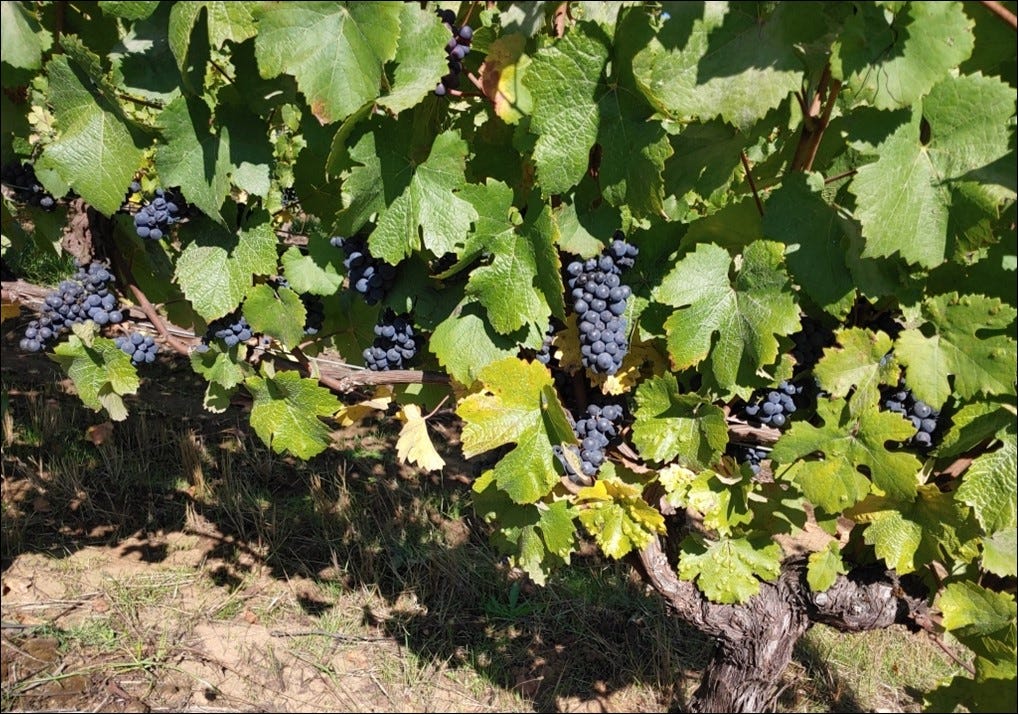
Pinot Noir awaiting The Great Cluster Pluck, Vintage 2020
September in Willamette Valley wine country, Vintage 2020. We will never know it all, but we now know enough to know - it is not farming good. This communication will lay out the events for the month that provided us all so much Mother Nature “Mama Drama” and we will endeavor to answer the question that may be on so many minds as we confront harvest, Vintage 2020.
What does that mean, and why should I care?

A once in a lifetime event
The month started out just great and that lasted for the first 7 days. Hey that’s 25% of the game and we will take it. The next 10 days provided a once in a lifetime wildfire and associated smoke event. This was due to the extreme winds originating in the central US blowing with tornado force gusts through Central Oregon. Central Oregon just happened to be ablaze with the Lionhead and Beachie Creek fires at that time. The Beachie Creek fire went from a relatively small fire of 500 acres to over 100,000 acres in the span of 24 hours. Simply unprecedented in living memory.

Winds blowing due west toward the Willamette Valley, Sept. 9th at 5:58 am
https://twitter.com/i/status/1303679122967728129
The easterly winds very quickly spanned the 60 miles or so between us and the Beachie Creek fire. The result can best be described as waking up to a full solar eclipse. The smoke remained in the valley and was fed by southwesterly winds for several more days. All vineyard work was ceased due to air quality conditions.
The next few days, September 17th - 19th, provided some relief in the form of northwest winds ushering in cool rain – 0.97 inches to be exact. This rain was preceded by a smashing crescendo of thunder and lightning – quite a show to be sure and very hard to miss. Note: Our records indicate Vintage 2019 received exactly 0.97 inches of rain September 16th - 18th. Most likely a glitch in the matrix.
The following week, or most of it, was spent assessing the potential impacts of smoke exposure and smoke taint. The short answer is that if you had significant smoke exposure any smoke molecules that landed on the wine berries are now bound up in the skins or more likely bound to a sugar molecule inside the wine berry. This phenomenon does not always lead to smoke taint, but sometimes it does. In past years we have had California smoke (from forest fires) in the air, but no smoke taint.
And then there was even MORE rain from September 24th – 26th. We add another 1.87 inches to the previous 0.97 inches and that provides us with 2.84 inches of rain coming up to The Great Cluster Pluck. Available soil moisture to the vines is no longer an issue for Vintage 2020. One less thing to worry about.
The rest of the month was much like the first of the month. Very pleasant, cool breezes, high temperatures in the low 80’s and low temperatures in the 40’s. EXACTLY how you want September to pass the torch to Okto-Vember.
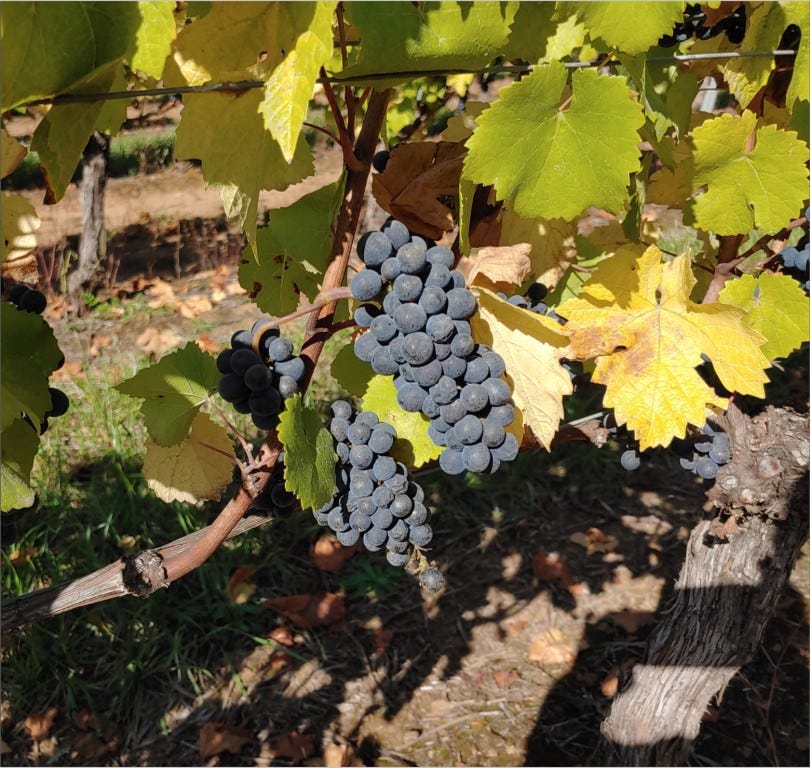
Ready and waiting to go to the winery to get weighed
Now we get to the essence of winegrowing in a post-apocalyptic environment. What does all of this mean, and why should I care?
The first answer is we no longer have to worry about high alcohol wines. Near enough to 3 inches of rain in mid to late September has allowed the vine roots to bring up water that is diluting the sugar concentrations in the wine berry. This is a good thing as high sugar concentrations turn into high alcohol wines. No one likes that, mostly.
Diluted sugar concentrations do NOT mean diluted aroma and flavor. Quite the opposite is true. By diluting the sugar concentrations, we can allow the wine berries to hang longer into the growing season to develop MORE aroma and flavor. And the rootstock most adapted to this “win-win” scenario is our old friend 5C. That’s 5C on Bellpine soil mind you. Right here in Dallas, Oregon, zip code 97338.
But there is a limit. 3 inches of rain this late in the growing season over a 2 week window awakens our nemesis Botryotinia fuckeliana. The noble version of this mold is responsible for those heavenly sauternes and the once in a lifetime Pabuk’s Gift Late Harvest Chardonnay. But most of the time in the Willamette Valley, we get plebian bunch rot and there is a saying that goes along with it. Specifically (in relation to trying to make wine from the Botryotinia fuckelianainfected wine berries), “You can’t polish a turd.”
This means we have about 3 weeks before Botryotinia fuckelianawill compromise the wine berries rendering them unsuitable for ultra-premium wine production. So, we need to get to Cluster Plucking while the Cluster Plucking is good, or we will be fuckeliana’d.
In contrast to several recent hot vintages, excess sugar concentrations were forcing early harvest schedules. Now we have the luxury of lower sugar concentrations to gain hangtime, but this is checked by a shortened harvest window due to the threat of developing Botryotinia fuckeliana. Somewhere in all of that from here to mid to late October is a sweet spot where a significant amount of Cluster Plucking would normally occur.
Before we dive into the qualitative aspects of Vintage 2020, let’s take a look at the quantitative aspect – The Numbers. September added 435.6 Degree Days to the vintage providing a growing season to date total of 2,210.8 Degree Days.
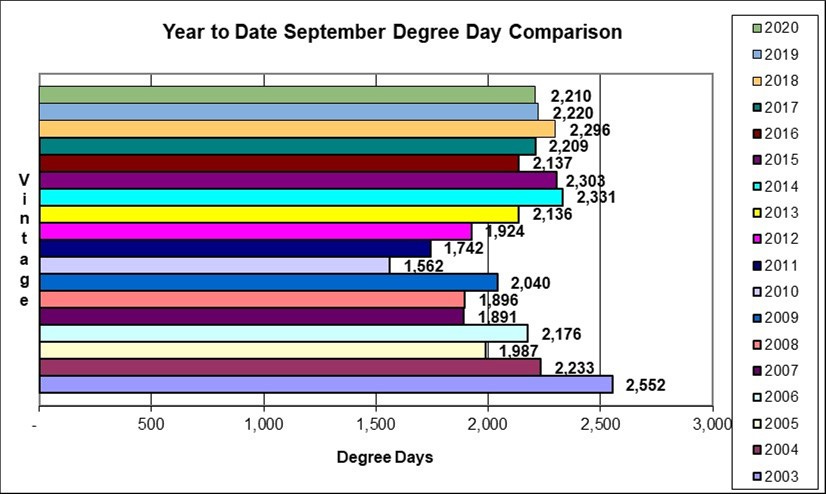
The high temperature for the month was 97.7 degrees recorded from 4:00 to 5:15 pm on September 3rd. The low temperature was 44.8 degrees recorded on September 13th from 7:24 to 7:48 am. Rainfall totaled 2.84 inches. While everyone likes to be clean for The Great Cluster Pluck and their trip to the winery to get weighed, we were a little over received on rainfall.
But what exactly, are we harvesting? Are these wine berries the sublime and ethereal beginnings of sublime and ethereal wines? Or is the smoke exposure event from mid-September going to reappear at the moment of truth in the glass? No one really knows for sure how this is going to play out. The new buzz word is “Guaiacol.” And, you don’t want any of it in your wine berries.
What we do know is that during fermentation the sugar molecules are vanquished and alcohol is produced. If there were smoke molecules bound to a sugar molecule, they are now in the finished wine. Sometimes you can smell and taste them and sometimes you cannot. The only way to know for sure is to send a sample of a fermented wine to a lab to test for certain compounds associated with smoke taint.
This means we can know if our wines have the markers for smoke taint, but due to the backlog of everyone else wanting to know the same thing, at the same time, we cannot know before harvest. And here is the thing, the sample has three possibilities. This in itself presents a problem in that the standard 2-bit coin only has 2 sides, even the Vulcan ones. First, there could be no markers of smoke taint. Yippeeee, we are clean. The next thought is that you should have cluster plucked the entire field, not just the good blocks.

Shaded fruit zone to impart elegant and refined tannins
The second easy answer is if the smoke taint markers are off the charts. Then you know you are doomed and can go out for tricks and treats with Charlie Brown. Or maybe not. There are ways of removing some of these smoke taint aromas, flavors and textures, but it means doing things. Doing things that we are not willing to do to a wine with our names on it.
And third, your results could come back with low levels of smoke taint markers. Then you have to decide how low is low enough. These smoke taint compounds are most likely bound up in the aroma, flavor, texture matrix of the wine and not detectable at this moment. But as the wine ages, those compounds could become volatile and then you can detect them. Hard to say at this point, but time will tell – on you.
But our very good industry partner ETS Laboratories run by the man, the myth, the legend Gordon Burns has devised this handy dandy interpretative chart to help guide the wine industry through our own apocalyptic pandemic.
As you look at this graphic, there are two red arrows. While they both point to the right, the top one is for samples of wine berries. The unit of measure is micrograms per kilogram. For those of you who no longer wear the white lab coat, a microgram is one millionth of a gram. There are 1,000 grams in a kilogram. That’s not a lot to work with, but it is why we pay Gordon the big bucks.
So, logically, if you have just 2 micrograms of Guaiacol in 1,000 grams of wine berries, Botryotinia fuckelianais no longer your primary concern. And get this, the wine berries taste good! So good in fact, you want to cluster pluck them and ferment the sugar out of them! That is what we have been pruning and preening the vines for all year.
And so you do, but only enough to do a microfermentation. This is typically about 20 pounds of wine berries and carries a winery designation such as BF “x.” Where BF represents Bucket Fermentation and “x” is the number of the fermentation in case you are “doing” multiple BF’s at the same time (or maybe just a replicated trial). This is chemistry, and something is bound to give a result that is more confusing than enlightening. So, add more trials and weed out the results that do not fit the standard bell curve. Besides, no one lives at either end of the curve anyway. Right, John?
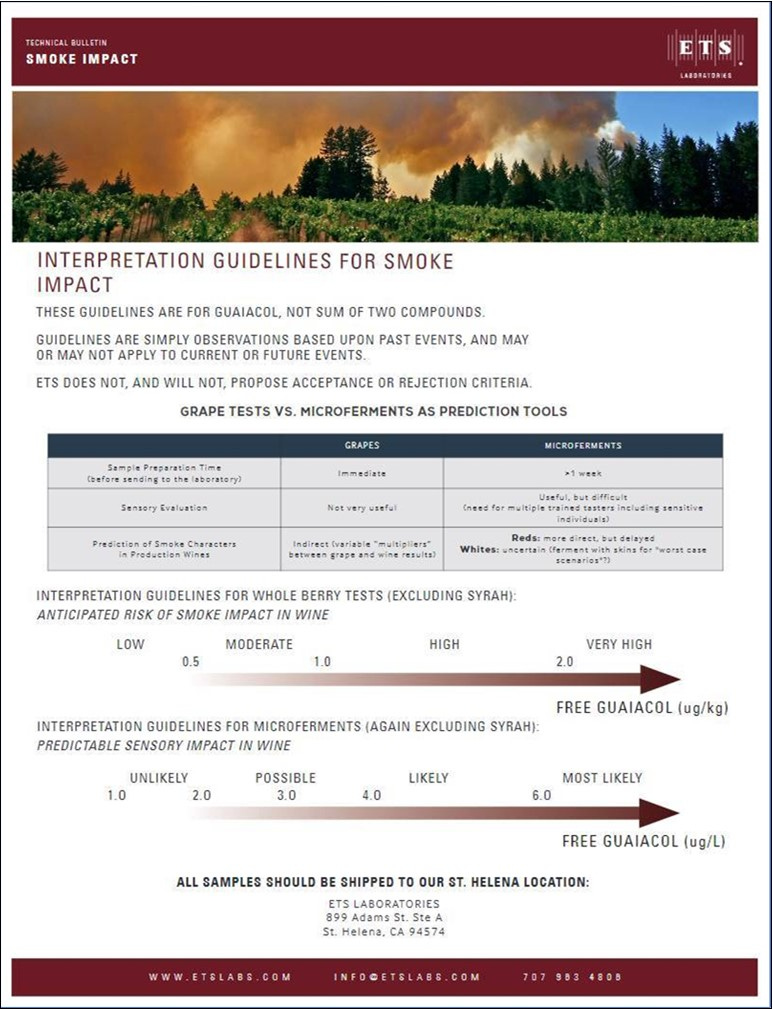
After doing your BF, you are at the second red arrow that points to the right. Here we see there is more leeway as we can go up to 6 micrograms of Guaiacol. However, the sample size is now a single liter of wine that has been fermented to dryness – no sugar left for the Guaiacol to bind to. And the Guaiacol is either volatile where it can be detected, or nonvolatile where it cannot be detected - at this time.
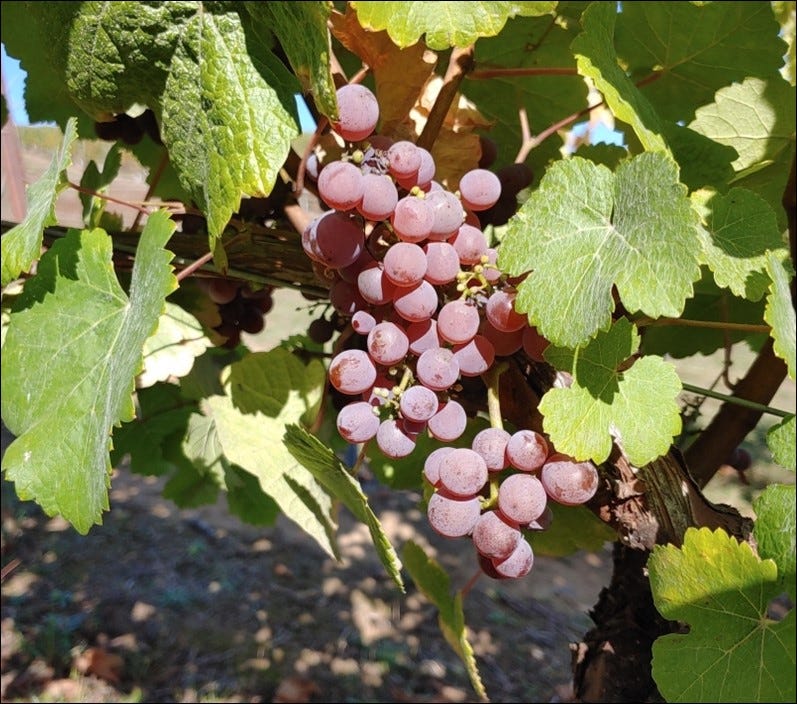
Gewürztraminer cluster ready to be microfermented
So if your wine sample results come back with a number greater than 1 but less than 3, you have a decision to make. You can harvest the wine berries and hope for the best or you can forgo the vintage and plan for vintage 2021. Ernie’s Gewürztraminer is going to be the test platform for our trials. He ferments it clean in stainless steel with no residual sugar. If there is smoke taint to be found in that wine, he will find it. It may take replicated sensory evaluation trials, but he will find it. Of course, there may not be any wine left to sell but at least we will be confident in our decision.
Kindest Regards,
Dena & Ernie



